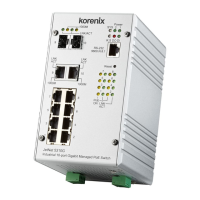Seamless Ring Port Restoration
TM
Seamless restoration is a new Korenix patented technology which can restore a failed
ring without causing any loop problem, topology change and packet loss. With a 0
second restoration time, this mechanism eliminates any unstable status and guarantees
the applications running non-stop.
Rapid Dual Homing (RDH
TM
) Technology
Rapid Dual Homing is also the important feature of Korenix new generation Ring
technology. It supports ring coupling with other vendors and with easy configuration and
multiple redundancies, the failover time is much faster and the restoration time is zero
ms. Uplinks can be auto detected and gathered into groups. In each group, uplinks are
sorted into primary, secondary and standbys by their link speed. The uplink with the
highest speed is more likely to be active path for data transmission. Link aggregation is
also integrated into RDH
TM
. An uplink connection can be a single link or several links
aggregated as a trunk, which provides better redundancy and link capacity.
TrunkRing
TM
TrunkRing is a new feature in MSR
TM
which merges the two technologies of RSR
TM
and
link aggregation. It takes advantages of aggregation to enhance the link redundancy,
while increase the link speed. The ring will open only if all the aggregated links are
broken. Link aggregation can be achieved by either, static trunk or LACP. Not all the link
sections in a TrunkRing need to be the same. Ring links can be either symmetric or
asymmetric. Some are a single path, and the others are aggregated by links where the
number of links in a trunk group can be different. Users can enhance the link redundancy
at different locations in accordance to the need. And the link with less speed is more
likely to be used as the backup path for restoring the network to full play capacity.
Link Aggregation Control Protocol
Link Aggregation Control Protocol allows you grouping multiple Ethernet ports in parallel
to increase the link bandwidth. The aggregated ports can be viewed as one physical port,
so that the bandwidth is higher than just one single Ethernet port. The member ports of
the same trunk group can balance the loading and backup with each other. The LACP
feature is usually used when you need higher bandwidth for the backbone network. This
is a cost-effective way for you to transfer much more data.
Multi Powering Mechanism- User Manual, Forced and IEEE 802.3at LLDP Power
over Ethernet

